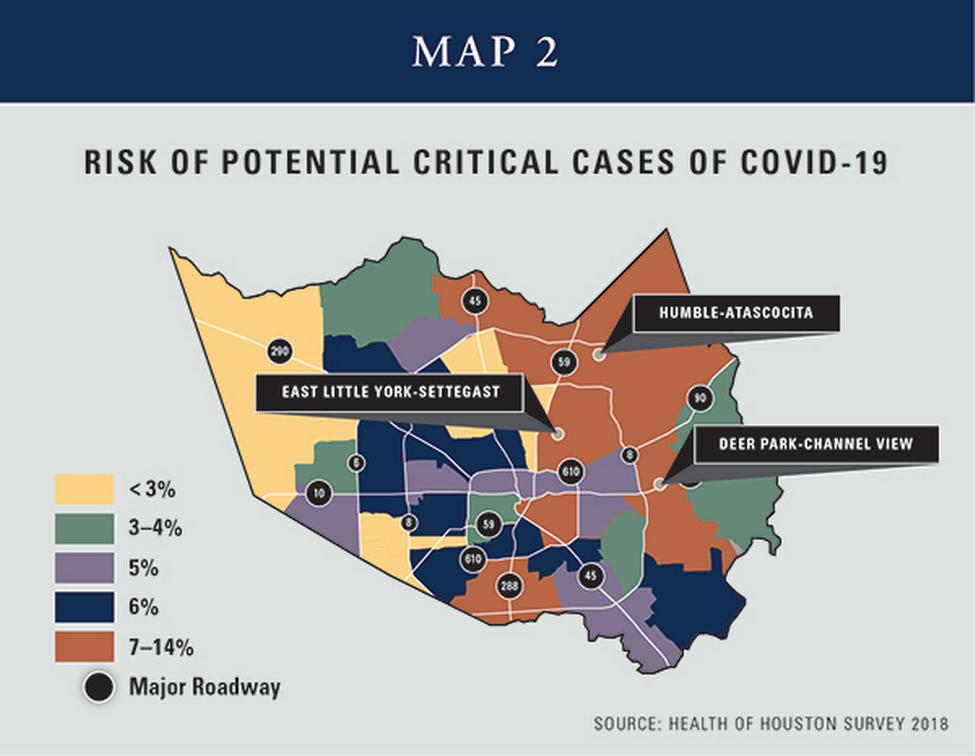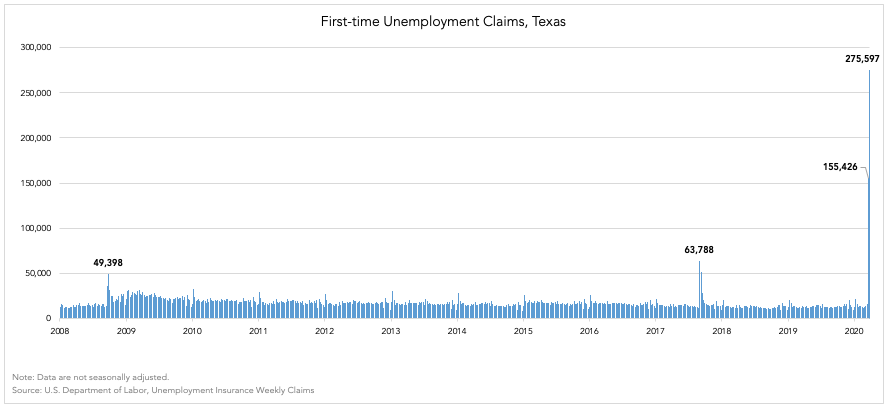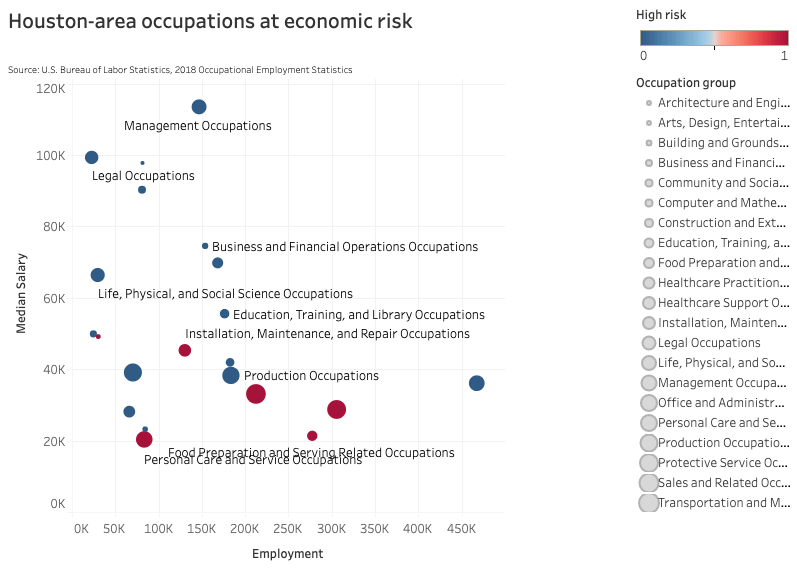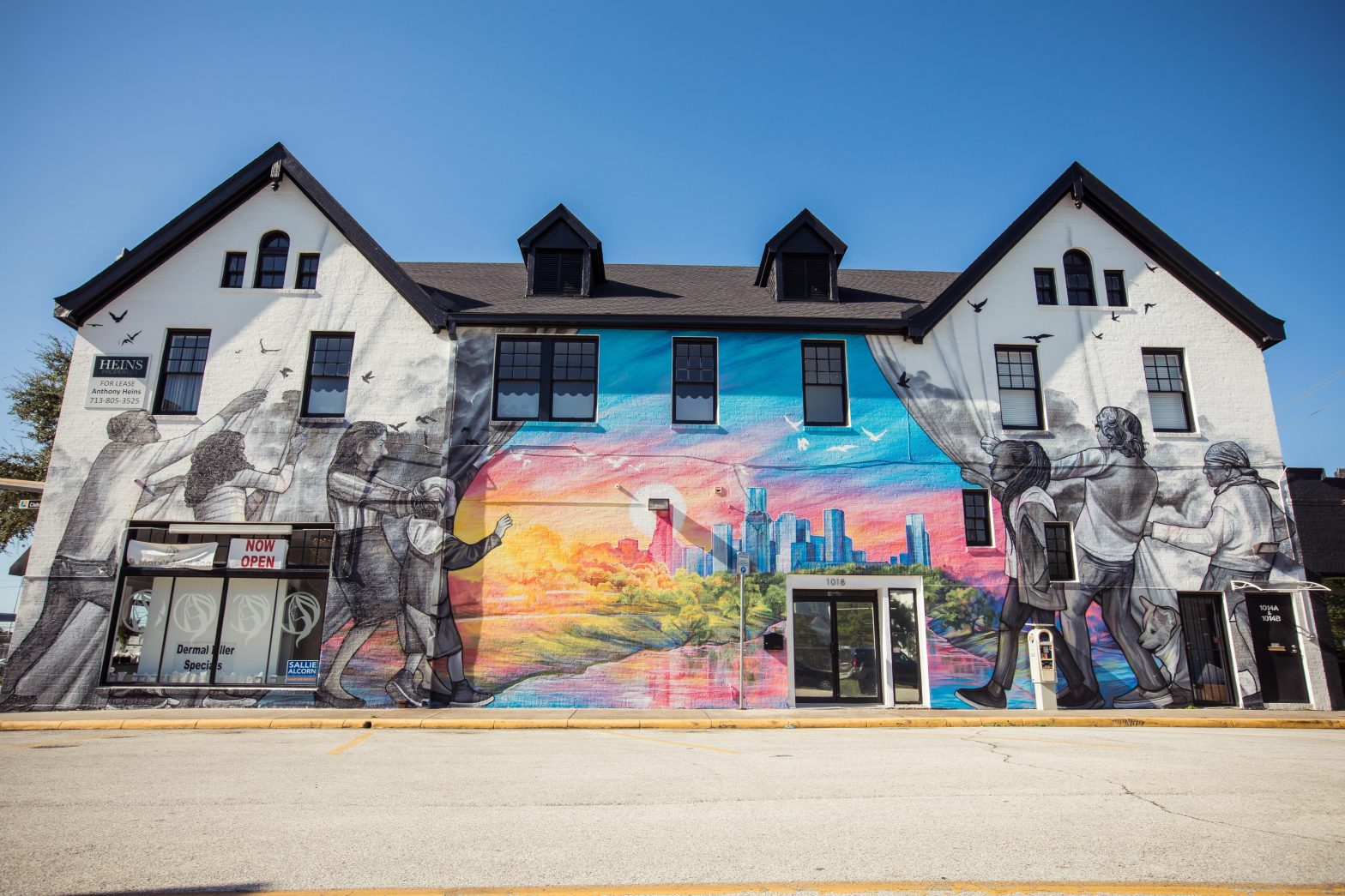COVID-19 has upended lives around the globe, and Houston is no exception. We continue to hear the worst is yet to come, but it’s difficult to fully comprehend what that means or take proper action without context. To mitigate the effects of this global public health crisis in our region, we must understand the scope of vulnerability in the Greater Houston area.
While we can’t predict the future of COVID-19, we can use local data to better understand what may be in store for our region so we can take collective action to reduce the risk to the most vulnerable communities.
Want to give back and get involved? Visit greaterhoustonrecovery.org to learn more about the Greater Houston COVID-19 Recovery Fund, and how your support can help our neighbors who need it the most.
The “current” state of affairs
It’s challenging to stay fully informed of the crisis as the number of cases, deaths and recoveries varies depending on when and where you look. Officially, the Centers for Disease Control (CDC) reports more than 304,800 cases in the nation, while the Johns Hopkins Coronavirus Resource Center reports 339,000. The Texas Department of Health and Human Services is tracking more than 7,200 cases in the state as does the Houston Chronicle. What we do know is that the virus has been quietly spreading across the country for several weeks, and these figures are just the beginning.
Following the number of cases and fatalities is a good place to start in understanding the magnitude of the crisis, but it fails to account for the deeper ramifications COVID-19 may have for different people in our region. As with other disasters, the most vulnerable populations will be disproportionately affected. In this brief, we aim to identify and quantify vulnerable groups in our region that COVID-19 will impact in a variety of ways. While this is by no means an exhaustive list, we hope it informs our collective response in assisting those who need it most.
COVID-19 and health risks in the Houston area
At publication time, more than 72,000 people around the world have died from COVID-19 — nearly 15% of whom were Americans. While hospitalization figures are inconsistent among states, the COVID Tracking Project reports more than 41,500 cumulative hospitalizations across the nation. Of course, the novel coronavirus poses significant public health risks, but for some, the risks are much higher.
Older adults
CDC researchers found that COVID-19 fatality rates increase with age, particularly for those over the age of 65. Death rates for Americans 85 years and older range from 10% to 27%, followed by 3% to 11% among persons aged 65–84 years, 1% to 3% among persons aged 55–64 years, and less than 1% among persons younger than 20. These findings are consistent with data from the first two months of 2020 in China.1
More than 660,000 adults over the age of 65 live in Fort Bend, Harris, and Montgomery counties. Worse, more than 134,000 (about one in five) live alone, with particularly high concentrations in Fort Bend County. Given their heightened vulnerability to the effects of COVID-19, older residents who live alone may face additional challenges safely obtaining the supplies and resources they need in order to practice social distancing. We also know that 134,000 seniors live below 150% of the poverty level, further hindering their ability to weather this crisis.
People with chronic health conditions
People with chronic health conditions like diabetes, compromised immune systems, heart disease, and asthma are also at higher risk of contracting and succumbing to COVID-19. The Institute for Health Policy at UT Health Science Center of Houston conducted an analysis of Census data in Harris County to map individuals with the highest risk for hospitalization and critical care needs. UTHealth researchers found that areas with the largest proportions of residents at high risk of critical illness from COVID-19 include Deer Park-Channel View, East Little York-Settegast, and Humble-Atascocita.

The areas of Harris County where residents are mostly likely to need critical care for COVID-19 are shown in orange. (Photo by Heath of Houston/UTHealth)
Take a deeper look: Explore this interactive map to see how these and other risk factors correspond to confirmed COVID-19 cases in Harris County.
Uninsured
No one wants to get sick, but for those without health insurance, the stakes are even higher. The Houston Metropolitan Area is home to the largest number of uninsured in Texas, which has the largest number and rate of uninsured in the country. Workers without health insurance are most likely to be part-time, gig economy, or low-wage employees, which means they likely do not have paid sick leave, compounding risks.2
President Trump signed the “Phase 2 Stimulus Package” (the Families First Coronavirus Response Act) on March 18 which provides free testing, but individuals will still be responsible for paying their treatment costs. This could affect some of the more than 1.1 million people, including 184,300 children, in the three-county region who are uninsured.
Mental Health
Harris County issued the first stay-home order effective March 17, but many of us are into our third or fourth week of staying home. The mental and emotional toll of COVID-19, for even the least vulnerable among us, will only continue as the pandemic wears on. Anxiety about the health of loved ones and ourselves, isolation, loneliness, and joblessness can all wear down our sense of well-being as the outbreak’s severity increases.
Coronavirus-related stress likely exacerbates pre-existing mental health conditions and mental health care access challenges in our region. As of 2018, the percentage of adults experiencing frequent mental distress (14 or more days of poor mental health within a month) in Houston’s three largest counties ranged from 9% in Fort Bend County to 12% in Harris County, where more than half of confirmed Houston-area cases of COVID-19 have been reported.
While those who have access to mental health care may be able to continue treatment through remote appointments, many in the Greater Houston region lack access to care altogether. As of 2018, Houston’s three largest counties average one mental health care provider for every 988 residents, lower than the state average and less than half the national average.
Economic risks of COVID-19 in the Houston area
Layoffs due to COVID-19 have begun throughout the Houston area, adding to challenges in healthcare access, mental health and more. Nearly 10 million Americans have filed for unemployment for the first time in the past two weeks, more than 431,000 of whom are from Texas. For the first time, the CARES Act expanded unemployment benefits and loans to these workers, but the process to connect people to these resources in a timely manner will be challenging.
As the graph below shows, these figures are unprecedented. Patrick Jankowski, senior vice president of research at the Greater Houston Partnership estimates mid-March job losses are nearly 38,000 in Metro Houston, though those figures can’t be confirmed until jobs data come out in early May.

High-risk industries
The majority of unemployment claims are from workers in the service industry — hotels, bars, restaurants, entertainment, leisure — as well as retail and travel. One out of every five workers in the three-county region is employed in a sector at high-risk for job loss, totaling about half a million people. Houstonians in these high-risk industries earned nearly $4 billion in wages in the second quarter of 2019.

While these industries are at immediate risk from the economic effects of COVID-19, the steep decline in oil prices will have longer-lasting and wide-ranging implications for businesses and workers in the oil and gas industry. Houston, as the energy capital of the world, will certainly be disproportionately affected.
Low-wage workers
Not all occupations in the aforementioned industries are at risk for layoffs. National data show that low-wage, part-time, and hourly workers in specific sectors have been hit the hardest with job and wage losses. The graph below shows the number of jobs and median annual salaries for workers grouped by job function. Occupations that are most at risk (in red) have the lowest salaries. Traditionally, that also suggests workers are paid hourly, don’t have health insurance, and don’t receive paid sick leave. Many groups will be eligible for paid sick leave and unemployment benefits offered by the federal government’s response to COVID-19, but not all, and workers will still have to make the difficult choice between protecting their health or earning an income. The stakes are high as 40% of Houstonians don’t have $400 in savings to deal with an unexpected emergency.

Small businesses
Small businesses in particular are struggling as everyone is told to stay home, and revenue has plummeted as a result. Nearly 127,000 small businesses employ fewer than 500 people in our region and comprise half of Houston-area businesses—most of these (89,500) employ fewer than 10, according to U.S. Census Bureau County Business Patterns. About 38 percent of small businesses in our region are minority-owned, putting livelihoods at risk and compounding challenges minorities have historically faced.
A survey by the Greater Houston Partnership shows that 91% of its small business members (defined as 500 or fewer employees) have lost revenue, about half are not able to pay staff during the shut-down, and more than one-third have laid off workers. There is hope that recent federal legislation will slow some of the job losses as small businesses take advantage of the Paycheck Protection Program (PPP), which requires companies to use the majority of funds to continue to pay staff.
Vulnerable populations in the Houston area
In addition to the groups identified above, immigrants, those who experience homelessness, and school-aged children are especially vulnerable to the hardships caused by COVID-19. In general, residents who were struggling prior to the pandemic will face compounded economic hardship during the crisis. This includes individuals and families living in poverty and low-income working households, also called Asset-Limited, Income-Constrained, and Employed (ALICE). Again, what follows is not a complete list, but we hope to call out examples of people in our community who will need the most help.
Immigrants
Immigrants, especially those who are undocumented, are particularly vulnerable to crises like disasters and pandemics. Immigrants tend to have less access to information and services since they may not be as familiar with credible sources, or with knowing how to navigate the system, and are more likely to encounter language barriers.
More than 1.5 million Houstonians were born outside the U.S. but call the three-county region home—that’s one out of every four people. The Migration Population Institute estimates 473,000 undocumented immigrants live in Greater Houston. According to the Census Bureau, more than half of immigrants in the region speak English less than “very well.” A recent report from ProPublica highlights the obstacles limited English proficient speakers encounter trying to advocate for their medical care. Given there are more than 145 languages spoken in the region, the need for interpreters and translators right now is critical. To view a map of where immigrants live in Houston, click here.
Immigrants also tend to have less access to forms of federal and state assistance (even though most pay taxes) because they are typically excluded from government programs and they are less likely to take advantage of aid for which they are eligible. Compounding their vulnerability, immigrants are more likely to be uninsured and work low-paying jobs. They are also over-represented in sectors immediately affected by layoffs. Ironically, an analysis by the Migration Policy Institute found that six million immigrant workers are at the front lines of keeping Americans healthy and fed during the pandemic by working in hospitals, as care-givers, or on farms.
Immigrants without legal status will have an even harder time weathering this pandemic as they are not eligible to benefit from the trillions of dollars in aid the federal government is releasing. In fact, the CARES Act, the $2.2 trillion stimulus package signed by President Trump on March 27, explicitly excludes them. Even mixed-status tax-paying households where American-born children have at least one parent without legal status will be ineligible for benefits.
Those who are homeless
People experiencing homelessness are particularly vulnerable during this pandemic. Homeless individuals tend to be older, and are more likely to suffer from mental illness and chronic conditions, making them more susceptible to the virus. Additionally, it is nearly impossible to follow CDC guidelines regarding social distancing, staying home, and regular hand hygiene without a permanent residence.
A marginalized population in the best of times, the unique needs of these individuals are often deprioritized in times of crisis. According to 2019 data from the Coalition for the Homeless, nearly 4,000 sheltered and unsheltered people live in Fort Bend, Harris, and Montgomery counties. Houston Mayor Sylvester Turner announced on April 1 that the city will rent hotel rooms to shelter Houston’s homeless individuals, but this population will require much more support as this crisis continues.
School-aged children
While school districts in Texas are officially closed through May 4, many parents are preparing for schools to remain shuttered for the remainder of the academic year. Several organizations, districts, teachers, and parents have stepped up to ensure that children continue to learn, but with parents working from home and the general chaos COVID-19 has created, maintaining a high-quality education at home is challenging, particularly for low-income working parents and those without internet access or computers. For example, recent data from Los Angeles Unified (LAUSD), the second-largest school district in the country, show that about 15,000 high school students are absent online and have failed to do any schoolwork, and more than 40,000 (about one-third of all high schoolers) have not been in daily contact with their teachers since mid-March, suggesting that distance-learning is not reaching everyone.
Moreover, when students spend time away from school during the summer, they sometimes lose what they learned over the academic year, a concept known as “summer slide.” One study found that students lost between 25% and 30% of what they learned during the school year, with lower income students at a greater disadvantage than their wealthier peers. About 691,500 public school students (62% of students enrolled) in the three-county region are identified as economically disadvantaged, meaning they qualify for free or reduced-price lunch. For many children, these free or reduced-price school meals are their primary source of daily nutrition. And, for the 98,000 students with disabilities and special needs in our region, the consequences of being out of school for a prolonged amount of time could be even more serious.
Understanding challenges to help Houston move forward
COVID-19 may be the first pandemic any of us have lived through, but this is far from the first time Houstonians have dealt with adversity. We’ve seen how this community comes together — neighbor helping neighbor, stranger helping stranger. For the good of this region that we all call home, please stay home if you are able. The more we reduce our physical contact with each other, the more neighbors we can save. That, if anything, is clear.
There are still plenty of ways to help from home. The United Way of Greater Houston and the Greater Houston Community Foundation have established the Greater Houston COVID-19 Recovery Fund, endorsed by Mayor Sylvester Turner and Harris County Judge Lina Hidalgo, to support local nonprofits that help those we identified here and more. Visit greaterhoustonrecovery.org today to see how you can get involved.
Additional Resources:
- Greater Houston Community Foundation
- United Way of Greater Houston and Resources
- Fort Bend County Mental Health Hotline: (832) 363-7094
- Harris County (Harris Center) Mental Health Hotline: (833) 986-1919
- Montgomery County Mental Health Hotline: (936) 523-5040
- OpenRICE Nonprofit Resources
- Houston Immigration Legal Services Collaborative
- Smart Parents, an informational hub for Texas families and regional nonprofits
End Notes:
1 The same CDC study found that while fatality rates might be very low for young people, they are not entirely immune to the effects of COVID-19 — nearly 40% of those hospitalized for coronavirus from mid-February to mid-March were between the age of 20 and 54.
2 Recent federal legislation allows for paid sick leave.
